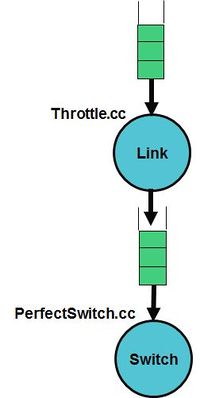Difference between revisions of "Simple"
From gem5
(Created page with "=== Simple Network === The simple network models hop-by-hop network traversal, but abstracts out detailed modeling within the switches. The switches are modeled in simple/Per...") |
|||
| (4 intermediate revisions by the same user not shown) | |||
| Line 1: | Line 1: | ||
| − | + | '''More details of the gem5 Ruby Interconnection Network are [[Interconnection_Network|here]].''' | |
| + | == Simple Network == | ||
| + | |||
| + | The default network model in Ruby is the simple network. | ||
| + | |||
| + | * '''Related Files''': | ||
| + | ** '''src/mem/ruby/network/Network.py''' | ||
| + | ** '''src/mem/ruby/network/simple''' | ||
| + | ** '''src/mem/ruby/network/simple/SimpleNetwork.py''' | ||
| + | |||
| + | == Configuration == | ||
| + | Simple network uses the generic network parameters in Network.py: | ||
| + | ** '''number_of_virtual_networks''': This is the maximum number of virtual networks. The actual number of active virtual networks is determined by the protocol. | ||
| + | ** '''control_msg_size''': The size of control messages in bytes. Default is 8. '''m_data_msg_size''' in Network.cc is set to the block size in bytes + control_msg_size. | ||
| + | |||
| + | Additional parameters are specified in simple/SimpleNetwork.py: | ||
| + | ** '''buffer_size''': Size of buffers at each switch input and output ports. A value of 0 implies infinite buffering. | ||
| + | ** '''endpoint_bandwidth''': Bandwidth at the end points of the network in 1000th of byte. | ||
| + | ** '''adaptive_routing''': This enables adaptive routing based on occupancy of output buffers. | ||
| + | |||
| + | == Switch Model == | ||
The simple network models hop-by-hop network traversal, but abstracts out detailed modeling within the switches. | The simple network models hop-by-hop network traversal, but abstracts out detailed modeling within the switches. | ||
The switches are modeled in simple/PerfectSwitch.cc while the links are modeled in simple/Throttle.cc. | The switches are modeled in simple/PerfectSwitch.cc while the links are modeled in simple/Throttle.cc. | ||
| Line 6: | Line 26: | ||
[[File:Simple_network.jpg|200px|center]] | [[File:Simple_network.jpg|200px|center]] | ||
| − | |||
| − | |||
| − | |||
| − | |||
| − | |||
| − | |||
Latest revision as of 01:41, 25 September 2016
More details of the gem5 Ruby Interconnection Network are here.
Simple Network
The default network model in Ruby is the simple network.
- Related Files:
- src/mem/ruby/network/Network.py
- src/mem/ruby/network/simple
- src/mem/ruby/network/simple/SimpleNetwork.py
Configuration
Simple network uses the generic network parameters in Network.py:
- number_of_virtual_networks: This is the maximum number of virtual networks. The actual number of active virtual networks is determined by the protocol.
- control_msg_size: The size of control messages in bytes. Default is 8. m_data_msg_size in Network.cc is set to the block size in bytes + control_msg_size.
Additional parameters are specified in simple/SimpleNetwork.py:
- buffer_size: Size of buffers at each switch input and output ports. A value of 0 implies infinite buffering.
- endpoint_bandwidth: Bandwidth at the end points of the network in 1000th of byte.
- adaptive_routing: This enables adaptive routing based on occupancy of output buffers.
Switch Model
The simple network models hop-by-hop network traversal, but abstracts out detailed modeling within the switches. The switches are modeled in simple/PerfectSwitch.cc while the links are modeled in simple/Throttle.cc. The flow-control is implemented by monitoring the available buffers and available bandwidth in output links before sending.
